Perth, the capital city of Western Australia, is home to a vibrant and diverse population of bird species. Located on the banks of the Swan River and surrounded by pristine beaches, nature reserves, and parks, Perth offers a unique habitat for birds.
The city is blessed with an abundance of native flora and fauna, which provide the perfect environment for a wide range of bird species to thrive. From bushland to wetlands, and from urban areas to coastal regions, Perth’s birdlife is a nature lover’s paradise.
This article will delve deeper into the fascinating world of birds in Perth, exploring their unique characteristics, habitats, and behavior.
1. Laughing Dove
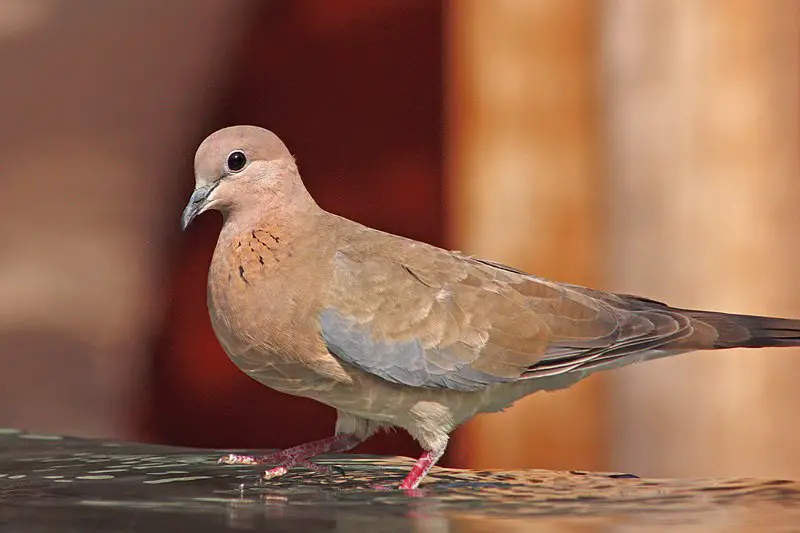
The Laughing Dove is a small and long-tailed pigeon found in dry, scrubby or semi-desert habitats. These birds are native to Africa, the Middle East, South Asia and Western Australia where they were released from Perth Zoo in 1898.
A unique feature of these doves is their call which sounds like low laughter – hence its name.
They form pairs when feeding on the ground, often near water sources such as pools or riverbanks. The diet of this bird consists mainly of seeds with some invertebrates also taking up part of it.
This species has adapted well to different environments due to its ability to find food resources easily even during times when other foods may be scarce.Scientific classification:
| Kingdom | Animalia |
| Phylum | Chordata |
| Class | Aves |
| Order | Columbiformes |
| Family | Columbidae |
| Genus | Spilopelia |
| Species | S. senegalensis |
Also Featured In: Egyptian Birds, Delhi Birds You Need to See
2. Honeyeaters
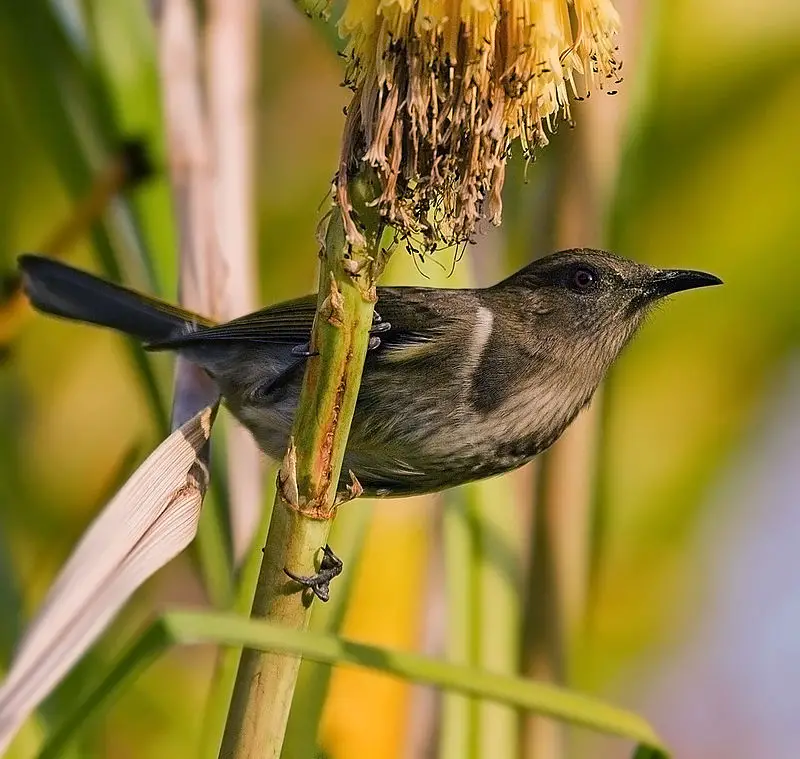
Honeyeaters are a unique and diverse family of birds, with species ranging in size from small to medium.
Found mainly in Australia and New Guinea, they can also be found as far east as Samoa and Tonga, or on islands such as Wallacea north or west of New Guinea.
Honeyeaters feed mainly on nectar but will consume insects if necessary for additional nutrition. They have specialized brush-like tongues that help them extract the nectar efficiently.
Their bright colours tend to make them stand out among other bird families making them easy to spot when out observing wildlife.Scientific classification:
| Kingdom | Animalia |
| Phylum | Chordata |
| Class | Aves |
| Order | Passeriformes |
| Superfamily | Meliphagoidea |
| Family | Meliphagidae Vigors, 1825 |
Also Featured In: Most common birds in Australia, Guam Birds You Need to See
3. Laughing Kookaburra
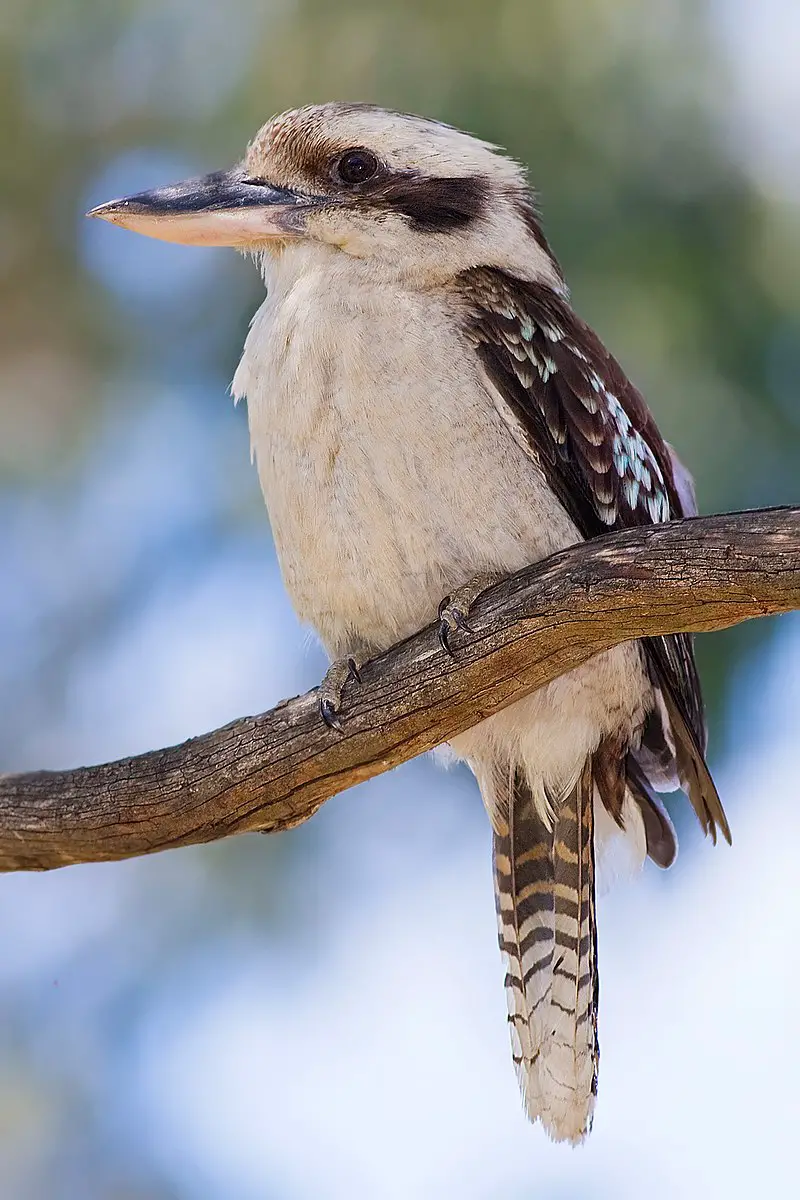
The Laughing Kookaburra is a beautiful bird with distinct features. It has a whitish head and brown eye-stripe, along with an upper body that is predominantly dark brown.
On its wings are mottled light blue patches which make it stand out even more. Its underparts are cream white while its tail is barred in rufous and black colours.
Male and female birds have the same plumage, making them easy to identify as belonging to this species of kingfisher subfamily Halcyoninae.
They can be found living around woodlands or open forests throughout eastern Australia, where they feed on small reptiles, insects or amphibians by swooping down from a perch above them before carrying their prey back up again for consumption.
The sound of their loud distinctive call – “koo-kaa-brrr” – brings joy to many Australians who appreciate these wonderful creatures inhabiting our landScientific classification:
| Kingdom | Animalia |
| Phylum | Chordata |
| Class | Aves |
| Order | Coraciiformes |
| Family | Alcedinidae |
| Subfamily | Halcyoninae |
| Genus | Dacelo |
| Species | D. novaeguineae |
Also Featured In: Birds You’ll Find in Zoo, Birds Typically Found in Australian Rainforest
4. Black Swan
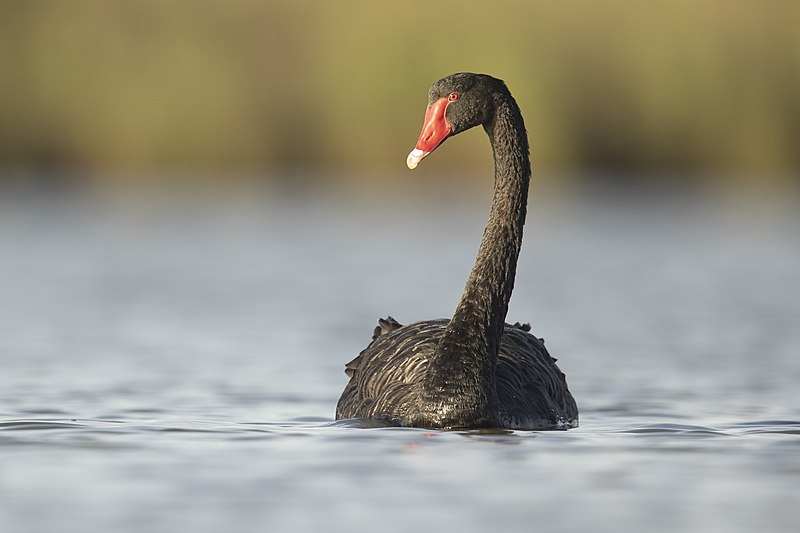
The Black Swan is a beautiful species of swan found in many parts of Australia. It has black plumage and a bright red bill, making it quite distinctive from other birds in the region.
These majestic birds are monogamous and both parents take turns incubating eggs as well as raising cygnets together.
They have an erratic migration pattern that depends on climatic conditions, although they usually move within their native range to find suitable habitats for breeding and feeding purposes.
The Black Swan’s graceful presence adds beauty to any water body they inhabit while also serving as important indicators of environmental health due to their sensitivity towards changes in their habitat quality.Scientific classification:
| Kingdom | Animalia |
| Phylum | Chordata |
| Class | Aves |
| Order | Anseriformes |
| Family | Anatidae |
| Genus | Cygnus |
| Species | C. atratus |
Also Featured In: Small Birds that Live in New South Wales, Black Birds in New Zealand
5. Splendid Fairywren
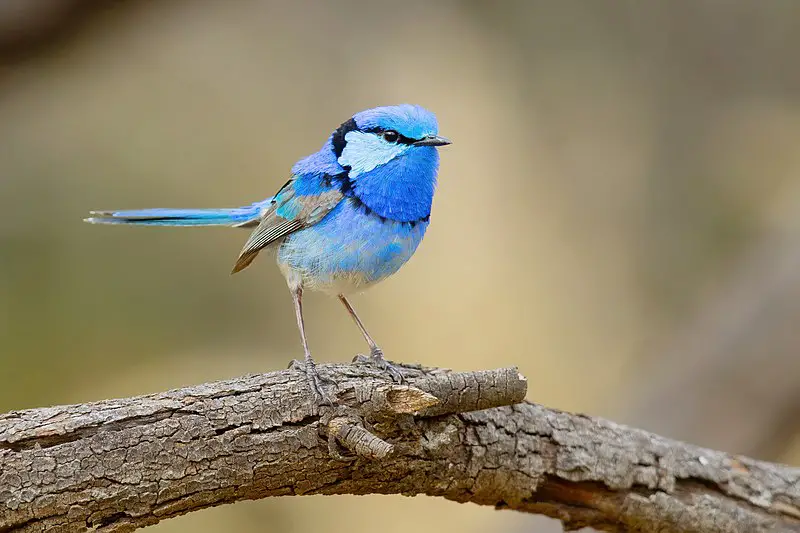
The Splendid Fairywren is a beautiful little passerine bird belonging to the Maluridae family. It can be found across much of Australia, from central-western New South Wales and southwestern Queensland over to coastal Western Australia.
This small wren resides in different pre-forested areas including woodlands, heaths and shrubbery as well as urban gardens; they often form lifetime pair bonds with each other during breeding season.
The male has an impressive display plumage that consists of bright blue on its wings, tail and rump while the female’s feathers are more brownish gray in color.
They feed mainly on insects but also eat nectar for sustenance when available. The Splendid Fairywren is quite common throughout its range thanks to their adaptability which allows them to thrive even near humans.Scientific classification:
| Kingdom | Animalia |
| Phylum | Chordata |
| Class | Aves |
| Order | Passeriformes |
| Family | Maluridae |
| Genus | Malurus |
| Species | M. splendens |
6. Carnaby’s Black Cockatoo
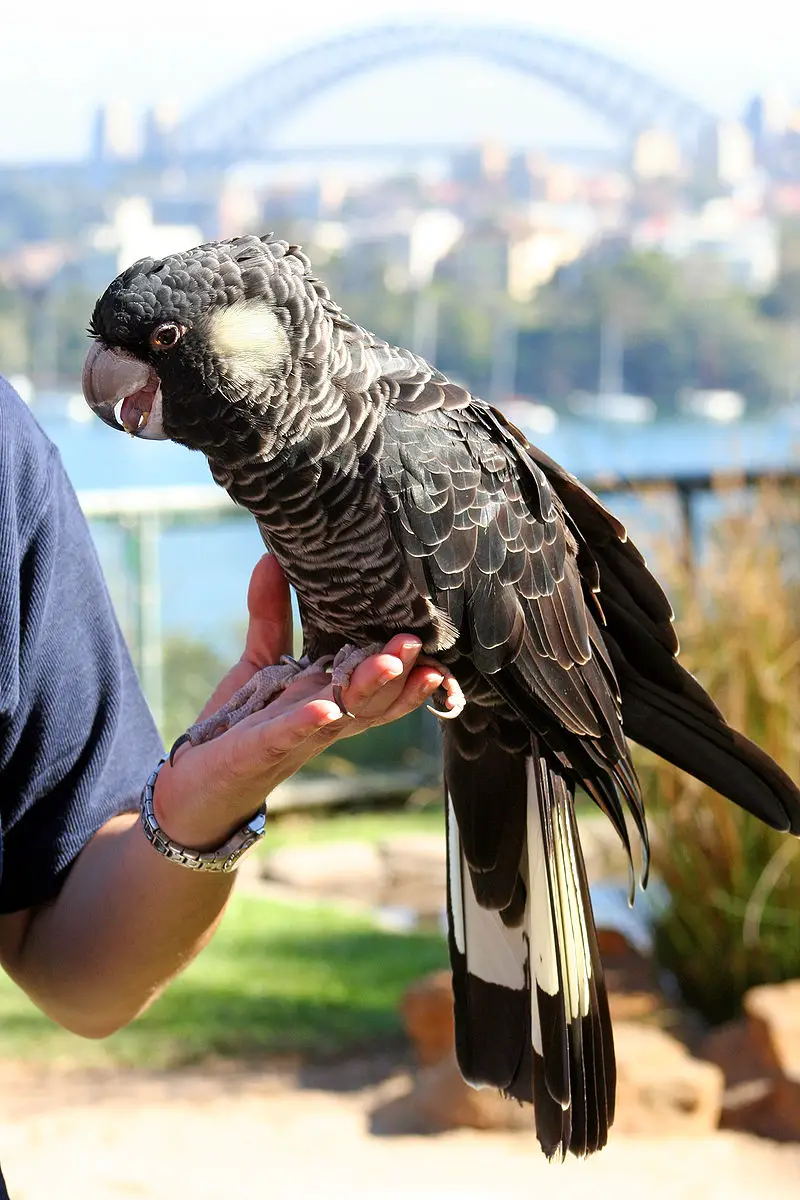
Carnaby’s black cockatoo is a large, stunning bird native to southwest Australia. Measuring 53-58 cm in length and with an unmistakable short crest on its head, the striking plumage of this species consists mostly of greyish black feathers.
It also has white cheek patches and a distinctive white tail band that makes it stand out from other members of its family.
Carnaby’s black cockatoo loves eating seeds, nuts, insects and flowers; however their numbers have been decreasing due to habitat loss.
Conservation efforts are necessary if we want these remarkable birds to continue living in our world for generations to come.Scientific classification:
| Kingdom | Animalia |
| Phylum | Chordata |
| Class | Aves |
| Order | Psittaciformes |
| Family | Cacatuidae |
| Genus | Zanda |
| Species | Z. latirostris |
7. Pelicans

Pelicans are a family of birds within the pelecani order, with two genera: Eopelecanus (extinct) and Pelecanus (still existing). They have been around since the late Eocene period — over 40 million years ago.
Pelicans are large waterbirds that can be found in both temperate and tropical regions all over the world.
Their most distinctive feature is their enormous pouched bills; they use these to scoop up fish from rivers or lakes as part of their diet.
These majestic creatures come in various colors, including white, grey, black and browns. When flying in formation they look like an arrow pointing towards its destination.
Pelicans usually live near bodies of water but may also migrate long distances when food resources become scarce during winter months.Scientific classification:
| Kingdom | Animalia |
| Phylum | Chordata |
| Class | Aves |
| Order | Pelecaniformes |
| Family | Pelecanidae Rafinesque, 1815 |
Also Featured In: Most Beautiful birds of Greece, Common Uzbekistan Birds
8. Dusky Moorhen
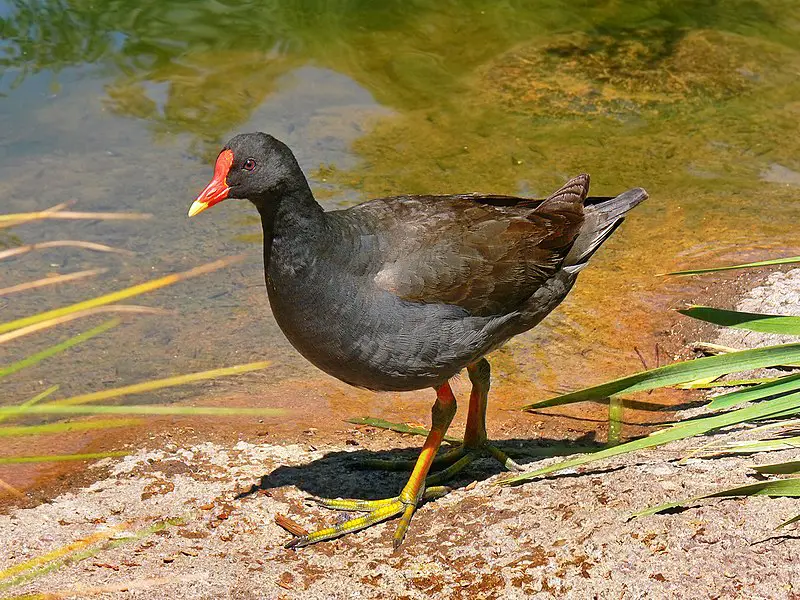
The dusky moorhen is a species of bird found in India, Australia, New Guinea, Borneo and Indonesia. It has dark plumage with an iridescent green sheen on its back and wings.
Its beak and legs are yellow-orange in color. The tail is long and pointed. Dusky moorhens live around freshwater wetlands such as swamps or ponds where they feed largely on aquatic vegetation but may also eat small insects or fish if available.
They often live alongside other birds from the same genus like purple swamphens or Eurasian coots which have similar appearances but different habitats preferences than their own species’.
Although timid when approached by humans these birds still make fascinating subjects for observation due to their unique behaviors within family groups that can help us understand more about them.Scientific classification:
| Kingdom | Animalia |
| Phylum | Chordata |
| Class | Aves |
| Order | Gruiformes |
| Family | Rallidae |
| Genus | Gallinula |
| Species | G. tenebrosa |
Also Featured In: Timor-Leste birds, Native Birds Of Mackay
9. Pied Stilt
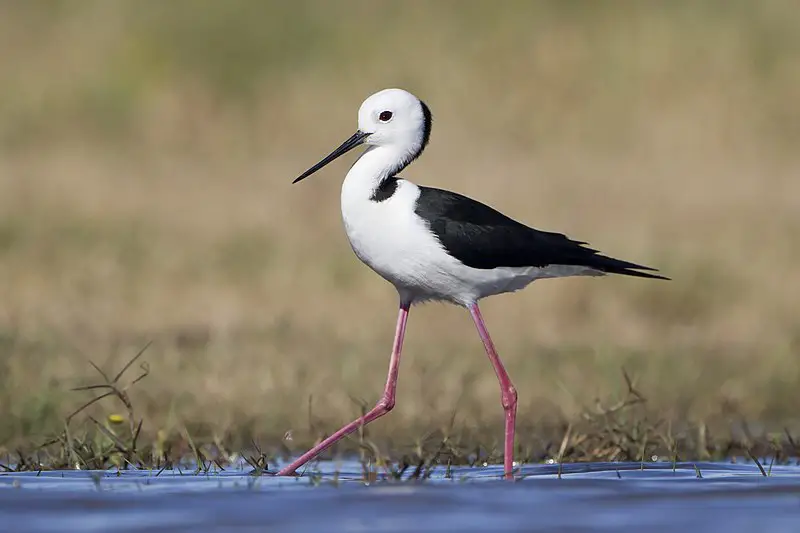
The Pied Stilt is a shorebird belonging to the family Recurvirostridae, and can be found in Malaysia, Japan, Philippines, Brunei, Christmas Island and other parts of Asia as well as Australia and New Zealand.
It has an impressive total population size with no apparent decline in numbers. This species stands out thanks to its white head which contrasts against its black neck and back feathers.
When feeding they wade through shallow waters or mudflats searching for small aquatic animals such as insects or crustaceans that make up their diet.
These birds are highly gregarious when nesting but disperse during winter months due to food shortage on the breeding grounds making them difficult to observe during this time of year.
Though currently listed as Least Concern by IUCN there could still be potential threats from human activities like habitat destruction so it’s important we continue monitoring populations closely into future years.Scientific classification:
| Kingdom | Animalia |
| Phylum | Chordata |
| Class | Aves |
| Order | Charadriiformes |
| Family | Recurvirostridae |
| Genus | Himantopus |
| Species | H. leucocephalus |
Also Featured In: Christmas Island Birds, Common Birds of Indonesia
10. Silver Gull

The Silver Gull is a common sight in Australia, especially along the coastlines. It’s smaller than the Pacific Gull and has silver-grey wings with white head and underparts.
Its scientific name is Chroicocephalus novaehollandiae, but it shouldn’t be confused with the Herring Gull which is also called “Silver Gull” in many other languages (Larus argentatus).
During summer months these birds can often be seen around fishing boats scavenging for discarded food or flying low over city parks looking for handouts from humans.
They are highly adaptable to their environment making them quite successful at coexisting near human populations.
These Australian seabirds have been known to live up to 25 years old.Scientific classification:
| Kingdom | Animalia |
| Phylum | Chordata |
| Class | Aves |
| Order | Charadriiformes |
| Family | Laridae |
| Genus | Chroicocephalus |
| Species | C. novaehollandiae |
Also Featured In: Gulls Species, Birds that Live around Brisbane
11. Red-Tailed Black Cockatoo
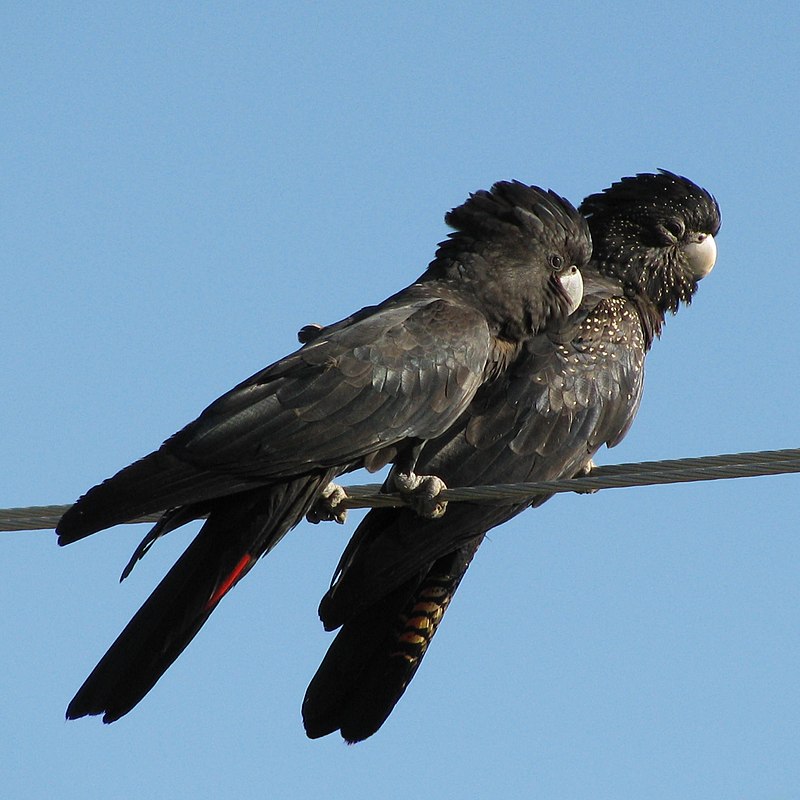
The Red-tailed Black Cockatoo is a majestic bird native to Australian mainland and nearby islands. It has an unmistakable appearance, with its black plumage and bright red tail panels that give it its name.
It thrives in dry environments across the continent, with five distinct subspecies recognized based on their beak size differences.
These birds are also known for their loud calls which can often be heard from miles away.
They love to feed on seeds found in eucalyptus trees and they have strong family bonds where parents will help raise young hatchlings together until they reach adulthood.
The Red-tailed Black Cockatoo is truly a beautiful sight to behold when spotted out in nature.Scientific classification:
| Kingdom | Animalia |
| Phylum | Chordata |
| Class | Aves |
| Order | Psittaciformes |
| Family | Cacatuidae |
| Genus | Calyptorhynchus |
| Species | C. banksii |
Also Featured In: Parrots Species, Most Common Western Australia Birds
12. Australasian Gannet
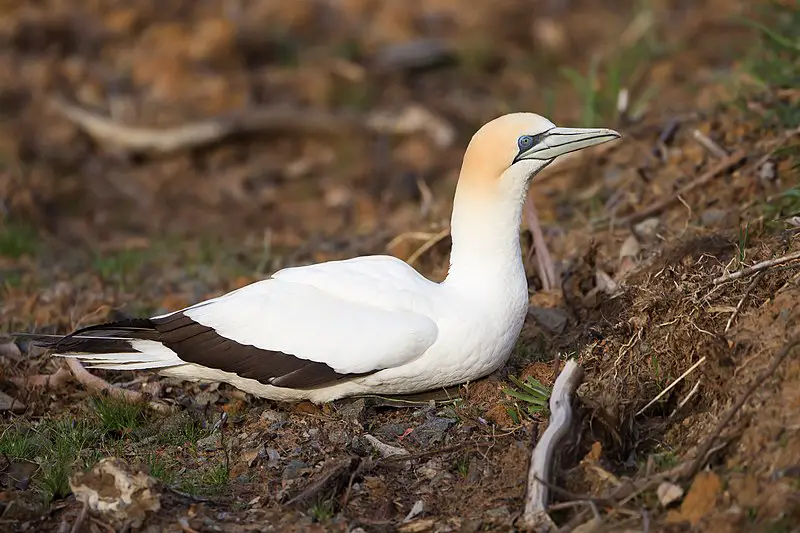
The Australasian gannet is a beautiful seabird with white feathers and black flight feathers that line its wings. Its head has a buff-yellow hue, with blue-grey bill edged in black and bright blue eyes.
It belongs to the booby and gannet family of Sulidae birds. This bird can be found off the coasts of Australia and New Zealand as well as other nearby islands including Lord Howe Island, Norfolk Island, Kangaroo Island, Tasmania South Australia’s Fleurieu Peninsula etc.
As they are excellent swimmers they feed on fish at sea by plunging into water from great heights or near surface swimming along shoals of small fishes in shallow waters.
The name “gannet” comes from an old English word for “gans” meaning goose-like bird because it looks like one when flying high above the ocean but dives down gracefully while hunting fish underwater.Scientific classification:
| Kingdom | Animalia |
| Phylum | Chordata |
| Class | Aves |
| Order | Suliformes |
| Family | Sulidae |
| Genus | Morus |
| Species | M. serrator |
Also Featured In: Booby Species, Birds that Live in the Ocean
13. Australasian Darter
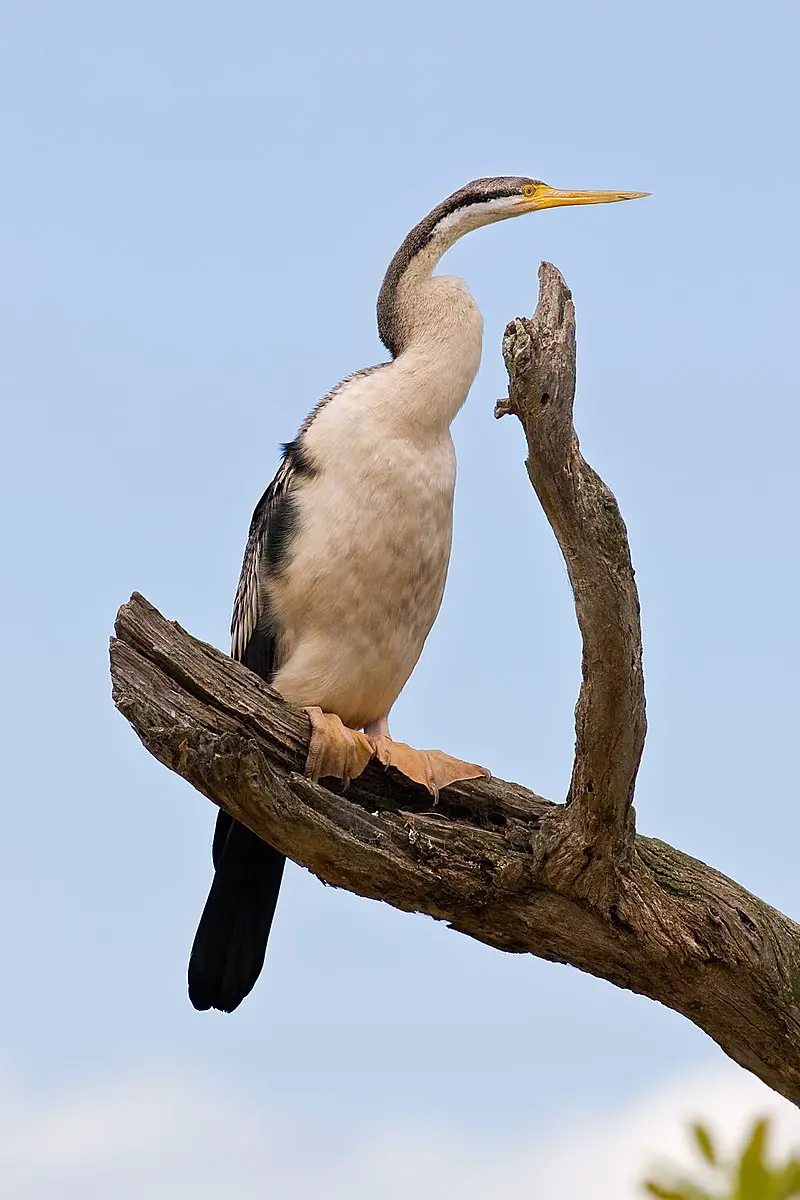
The Australasian Darter, also known as the Australian Darter, is a species of bird in the darter family. It can be found across Australia, Indonesia and Papua New Guinea.
This large bird has an impressive wingspan between 86-94 cm and weighs up to 2.6 kgs.
First discovered by John Gould in 1847, this long necked creature loves to swim and hunt for food underwater before drying its feathers on tree branches or rocks afterwards – like other Anhingidae species do.
They mainly feed on fish but will eat crustaceans too if they are around. With beautiful black plumage with white markings on their wings and tail these birds stand out from most others due to their unique style when it comes to fishing.Scientific classification:
| Kingdom | Animalia |
| Phylum | Chordata |
| Class | Aves |
| Order | Suliformes |
| Family | Anhingidae |
| Genus | Anhinga |
| Species | A. novaehollandiae |
Also Featured In: Cormorant Species, Birds that Found in Kakadu National Park
14. Grey Butcherbird
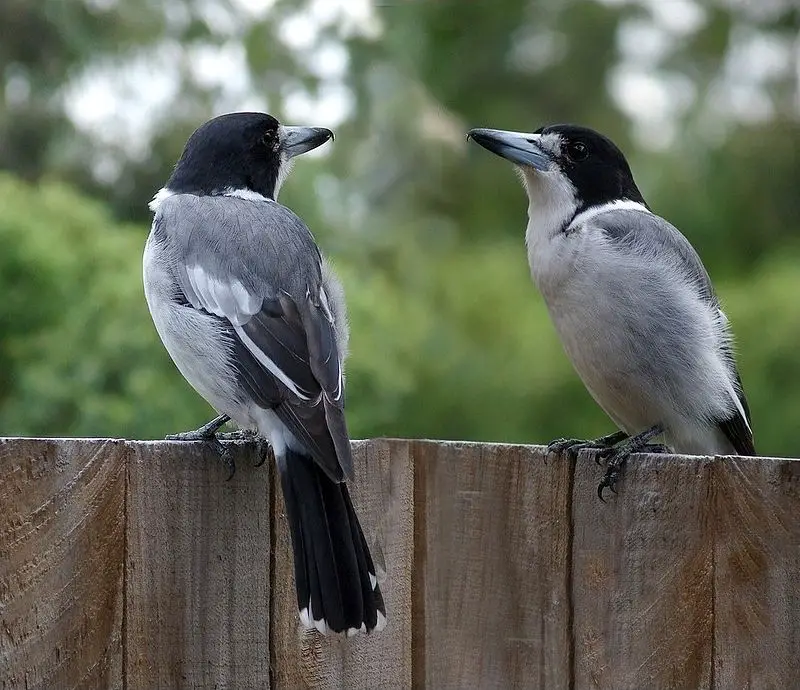
The Grey butcherbird is a species of bird found exclusively in Australia. It can be found in several different environments, including semi-arid and temperate zones.
The bird has a unique and distinctive birdsong. The Grey butcherbird is absent from the deserts of central Australia and the monsoon tropics of the north. It appears to be adaptable to its surroundings.Scientific classification:
| Kingdom | Animalia |
| Phylum | Chordata |
| Class | Aves |
| Order | Passeriformes |
| Family | Artamidae |
| Genus | Cracticus |
| Species | C. torquatus |
Also Featured In: South Australian Birds, Birds of Tasmania
15. Australian White Ibis
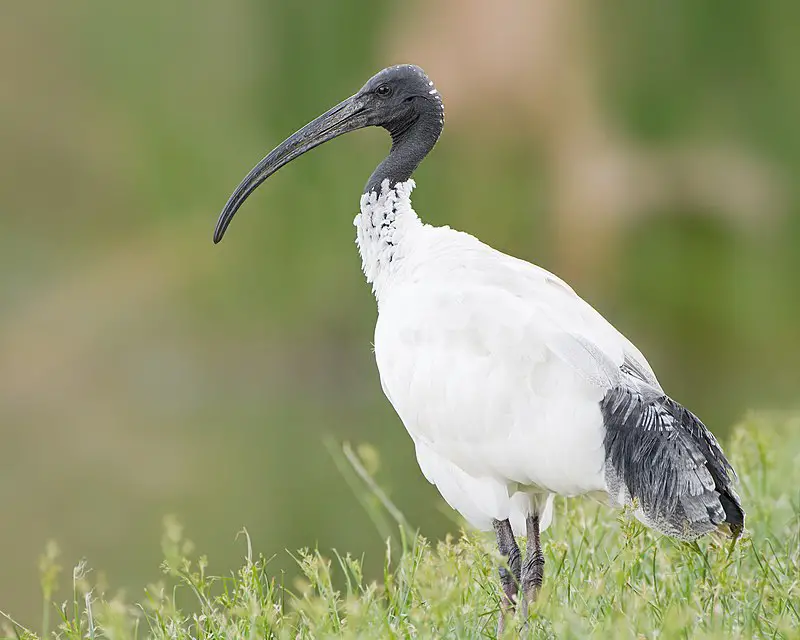
The Australian white ibis is a native wading bird of Australia. With its predominantly white plumage and long downcurved bill, it is easily recognized.
The bird is often found foraging for food on open grasslands, pastures and urban areas such as parks and gardens.
Despite being closely related to the African sacred ibis, the Australian white ibis is a separate species. It has a bare, black head and black legs.
The bird is well adapted to urban environments and often scavenges for food from waste bins or on streets.
While it has been subjected to negative perceptions due to its scavenging behavior, it remains an important member of the Australian ecosystem.Scientific classification:
| Kingdom | Animalia |
| Phylum | Chordata |
| Class | Aves |
| Order | Pelecaniformes |
| Family | Threskiornithidae |
| Genus | Threskiornis |
| Species | T. molucca |
Also Featured In: Water Birds Live around Us, Birds that Live around Victoria
16. Australasian Grebe
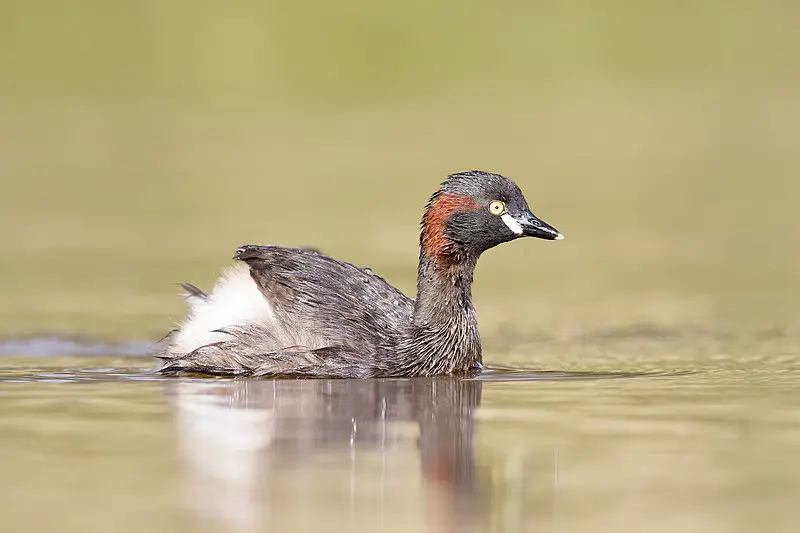
The Australasian grebe is a small waterbird that is frequently seen on fresh water lakes and rivers in Australia, New Zealand, and the Pacific islands. It is one of the smallest members of the grebe family, measuring only 25-27 cm in length.
The bird has a dark brown upper body and a glossy-black head and neck, making it quite striking in appearance.
Both male and female Australasian grebes look alike, and the species is known for its strong swimming and diving abilities.
Due to its reliance on freshwater ecosystems, the Australasian grebe is highly vulnerable to habitat loss and other environmental threats.
Conservation efforts are underway to protect this unique and important bird species.Scientific classification:
| Kingdom | Animalia |
| Phylum | Chordata |
| Class | Aves |
| Order | Podicipediformes |
| Family | Podicipedidae |
| Genus | Tachybaptus |
| Species | T. novaehollandiae |
Also Featured In: Queensland Birds You Should Know, Common Melbourne Birds
17. Pacific Black Duck
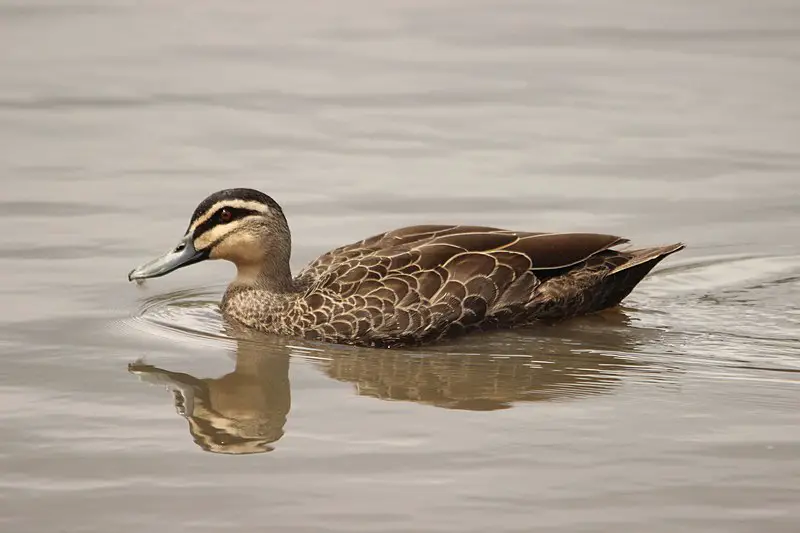
The Pacific black duck, also referred to as the gray duck in New Zealand, is a type of dabbling duck that can be found in numerous countries ranging from Indonesia to French Polynesia.
Its scientific name is Anas superciliosa. In New Zealand, the duck is often called by its Maori name, pārera.
The Pacific black duck lives in a variety of habitats, such as wetlands, marshes, and rice paddies.
It has distinctive features, including a dark body with white specks, a slightly curved beak, and a light-colored crown.
This duck is a common sight in its range, and it feeds on a variety of items such as insects, small fish, and seeds.
The Pacific black duck is an important part of the ecosystem and can even be hunted for food in some areas.Scientific classification:
| Kingdom | Animalia |
| Phylum | Chordata |
| Class | Aves |
| Order | Anseriformes |
| Family | Anatidae |
| Genus | Anas |
| Species | A. superciliosa |
Also Featured In: Sydney Birds You Need to See, New South Wales Birds You Need to See
18. Magpie-Lark
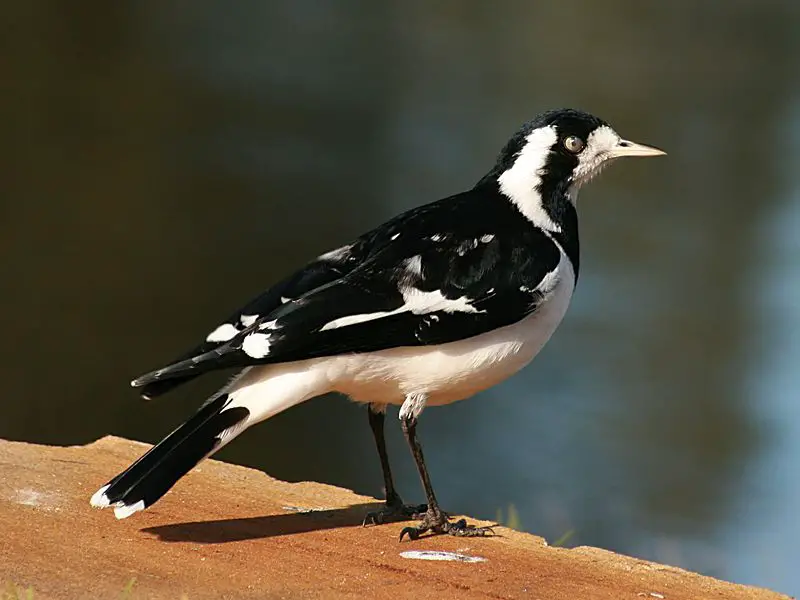
The Magpie-lark is a bird found in Australia, Timor, and southern New Guinea. It has black and white plumage, with different patterns for males and females.
John Latham first described this species in 1801. Formerly known as a mudnest builder, it has been reclassified recently.
The bird has several nicknames such as Wee magpie, Peewee, Peewit, and Mudlark.
It is a passerine bird, and its scientific name is Grallina cyanoleuca. The Magpie-lark is known for its beautiful call, which is similar to the sound “pee-wee.” It is a unique species that adds to the diversity of Australia’s wildlife.
The bird is a favourite among birdwatchers and nature lovers in general.Scientific classification:
| Kingdom | Animalia |
| Phylum | Chordata |
| Class | Aves |
| Order | Passeriformes |
| Family | Monarchidae |
| Genus | Grallina |
| Species | G. cyanoleuca |
Also Featured In: Birds that Charles Darwin Studied, Birds that Live Near Adelaide
19. Willie Wagtail
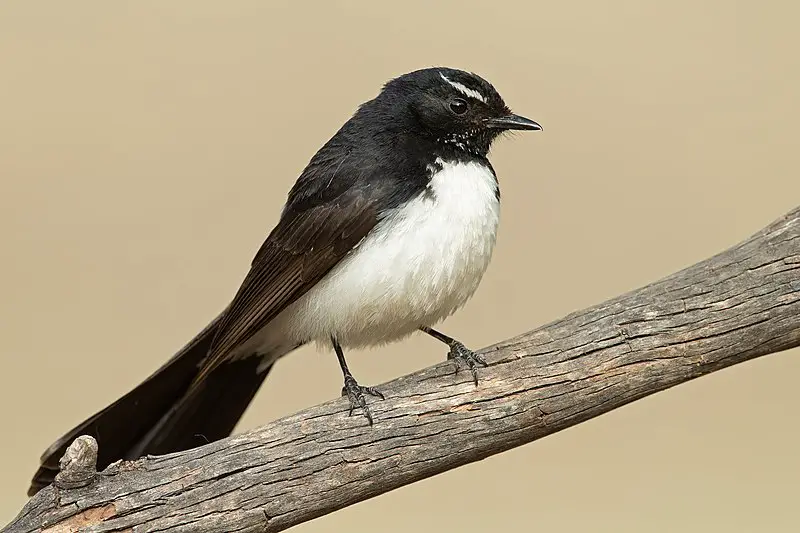
The Willie wagtail is a well-known bird in Australia, New Guinea, and other nearby regions. With its contrasting black and white plumage, this passerine bird stands out in most habitats, except for dense forests.
Its small size, measuring around 19- 21.5 cm in length, hints at its swift movements as it flies and dances through the air.
The Willie wagtail is a master of acrobatics and can quickly change direction while catching insects on the fly.
Its tendency to wag its tail up and down is how it got its name. This bird is a common sight in gardens, parks, and other open spaces, where it feeds on insects and small invertebrates.
Despite its size, the Willie wagtail is a bold and fearless bird and will attack much larger birds that threaten its territory.
Overall, this charming bird is a delight to observe in the wild.Scientific classification:
| Kingdom | Animalia |
| Phylum | Chordata |
| Class | Aves |
| Order | Passeriformes |
| Family | Rhipiduridae |
| Genus | Rhipidura |
| Species | R. leucophrys |
20. Freckled Duck
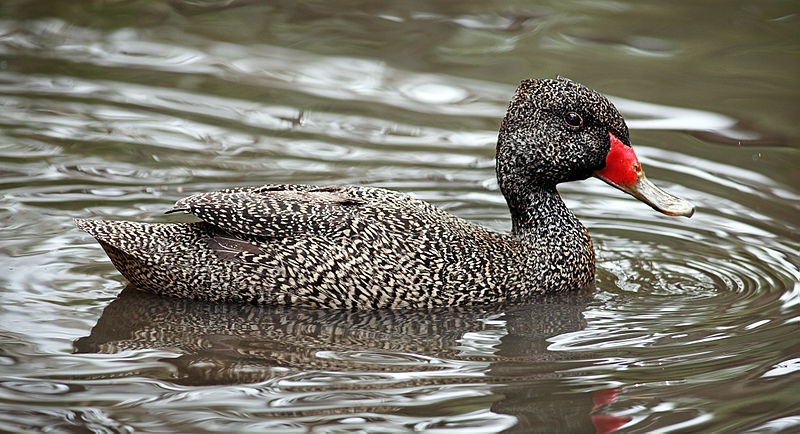
The Freckled duck is a unique waterfowl that can be found in mainland Australia. They are also known as monkey duck or oatmeal duck.
During the dry season, they disperse to coastal and subcoastal wetlands in search of water.
These birds are known for congregating in large flocks during this period. The Freckled duck has a distinctive appearance with its freckled plumage and blue-grey beak.
Its habitat is mostly in freshwater wetlands, and they feed on aquatic plants and small invertebrates.
While they are not considered endangered, their population is declining due to habitat loss and degradation.
Conservation efforts are being made to protect and preserve their natural habitats. The Freckled duck is a fascinating species that adds to the diversity of Australian wildlife.Scientific classification:
| Kingdom | Animalia |
| Phylum | Chordata |
| Class | Aves |
| Order | Anseriformes |
| Family | Anatidae |
| Subfamily | Stictonettinae Boetticher, 1950 |
| Genus | Stictonetta Reichenbach, 1853 |
| Species | S. naevosa |
21. Red Wattlebird
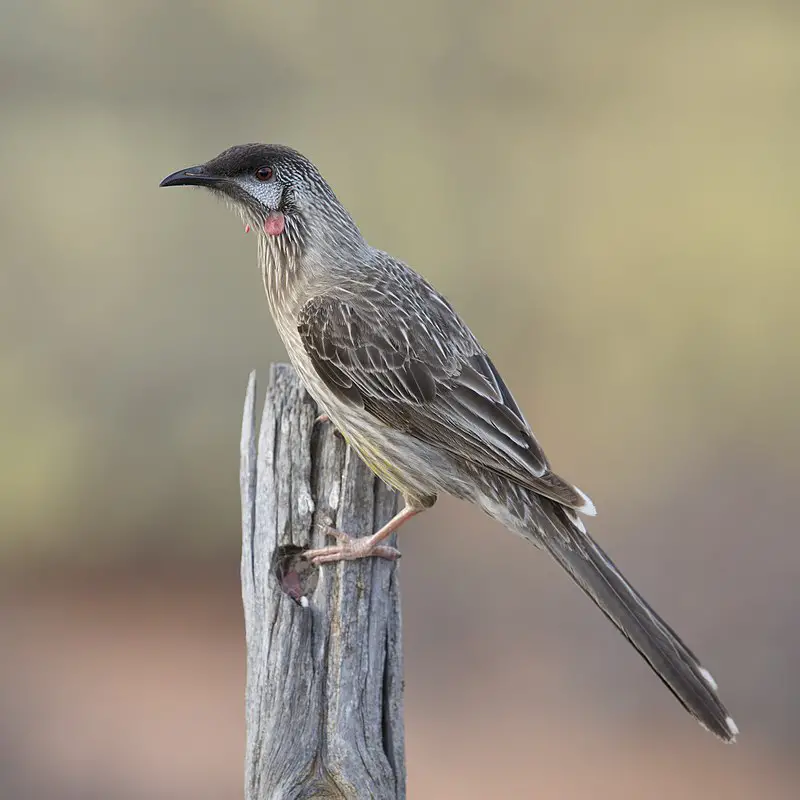
The Red Wattlebird is a large honeyeater found in southern Australia. It has grey-brown feathers, red eyes, and pinkish-red wattles on its neck.
The bird also has white streaks on its chest and a bright yellow patch on its belly.
It measures 33-37 cm in length, making it the second largest Australian honeyeater. The male and female birds have similar physical characteristics.Scientific classification:
| Kingdom | Animalia |
| Phylum | Chordata |
| Class | Aves |
| Order | Passeriformes |
| Family | Meliphagidae |
| Genus | Anthochaera |
| Species | A. carunculata |
22. Hoary-Headed Grebe
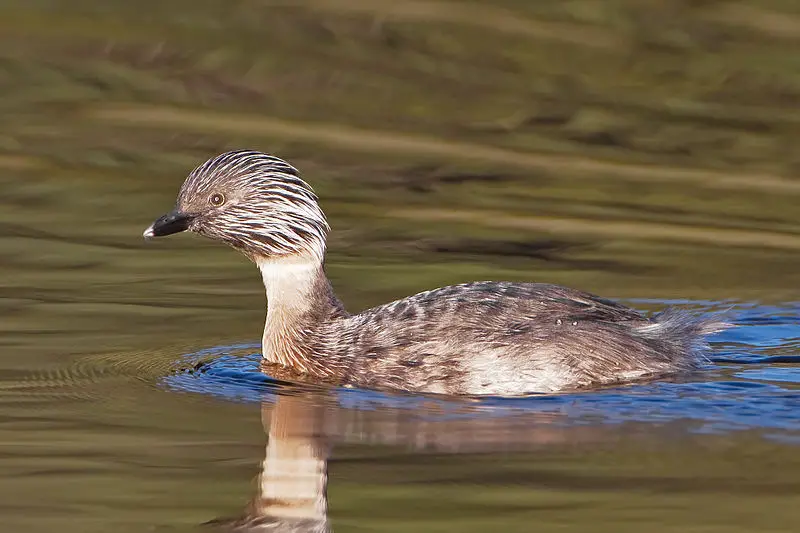
The hoary-headed grebe, also known as Poliocephalus poliocephalus, is a type of grebe that can be found in the southern parts of Australia with a population of about 500,000.
They migrate to the island of Tasmania during winters. This bird is named after the streaks of silvery-white color on its black head. The habitat of the hoary-headed grebe is similar to that of the Australasian grebe.
Despite being a common bird in Australia, it is still a fascination for birdwatchers.
The hoary-headed grebe is an aquatic bird that feeds on small fish and insects. It’s a sight to behold when it dives underwater to catch its prey.
The species is unique for its elegant appearance and incredible diving abilities.Scientific classification:
| Kingdom | Animalia |
| Phylum | Chordata |
| Class | Aves |
| Order | Podicipediformes |
| Family | Podicipedidae |
| Genus | Poliocephalus |
| Species | P. poliocephalus |
23. Red-Winged Fairywren
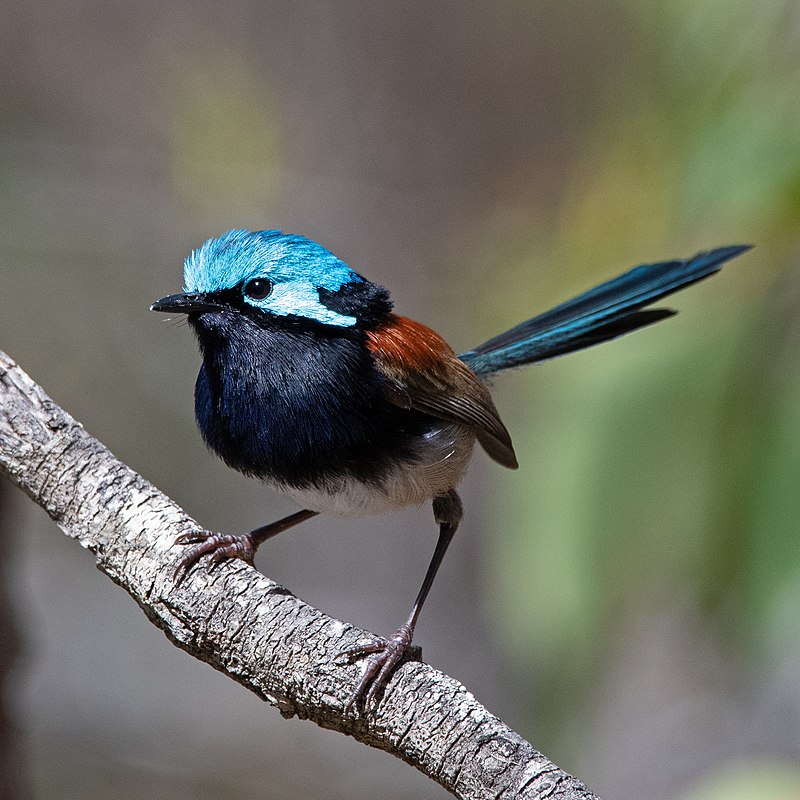
The Red-winged fairywren is a passerine bird found only in southwestern Western Australia.
This non-migratory species exhibits significant sexual dimorphism, as males have a strikingly colored breeding plumage with a silvery-blue crown, ear coverts, and upper back, along with red shoulders, while females have duller plumage.
Fairywrens are known for their complex social behavior, and these birds also have a unique mating system in which males are typically promiscuous with multiple females, who then form social bonds with one another.
Despite the bright colors of the males, they are actually quite difficult to spot in their natural habitat, frequently hiding in thick shrubs, so finding them takes patience and keen observation skills.
Overall, the Red-winged fairywren is a stunning example of the unique and diverse birdlife found in Australia.Scientific classification:
| Kingdom | Animalia |
| Phylum | Chordata |
| Class | Aves |
| Order | Passeriformes |
| Family | Maluridae |
| Genus | Malurus |
| Species | M. elegans |
24. Baudin’s Black Cockatoo
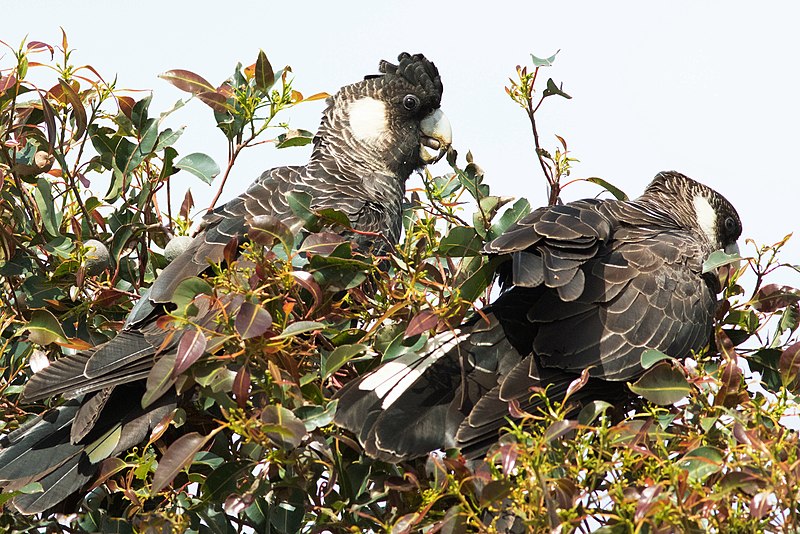
Baudin’s black cockatoo is a type of cockatoo found in southwest Australia. Its greyish black plumage is accentuated by prominent white cheek patches and a white tail band.
It is also known as the long-billed black cockatoo, because of its distinctively long beak. The species is named after French explorer Nicolas Baudin. These birds have short crests on the top of their heads.
Their feathers are edged with a softer shade that contrasts with the dominant black, lending the species a striking appearance.
Baudin’s black cockatoos are charismatic and intelligent birds that are popular among bird enthusiasts.
They are often kept as pets, but their wild populations are increasingly threatened by habitat destruction and climate change.Scientific classification:
| Kingdom | Animalia |
| Phylum | Chordata |
| Class | Aves |
| Order | Psittaciformes |
| Family | Cacatuidae |
| Genus | Zanda |
| Species | Z. baudinii |
25. Singing Honeyeater
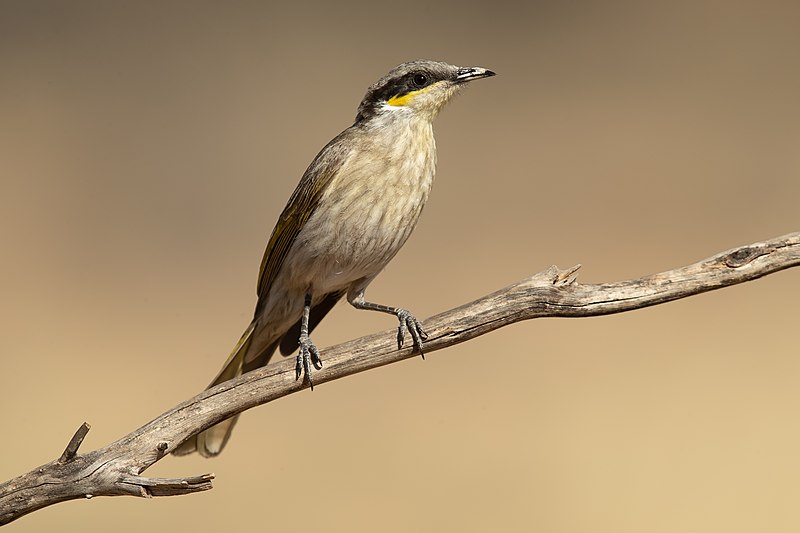
The Singing honeyeater bird is a small Avian species that belongs to the Meliphagidae family. It can be found in several different habitats including shrubland, woodland, and coastal regions.
The bird is prevalent and can be found throughout Australia west of the Great Dividing Range, and stretches to the west coast and Western Australian islands. Although it is widespread, this species is not found in Tasmania.
The name of this bird is derived from its beautiful and melodious singing that is often heard in the early morning. Singing honeyeaters are known to be a crucial species in the ecosystem as they help in pollination and seed dispersal.
These birds are known for their unique plumage, which is a mix of green and yellow, making them easily distinguishable from other species.Scientific classification:
| Kingdom | Animalia |
| Phylum | Chordata |
| Class | Aves |
| Order | Passeriformes |
| Family | Meliphagidae |
| Genus | Gavicalis |
| Species | G. virescens |
26. Elegant Parrot
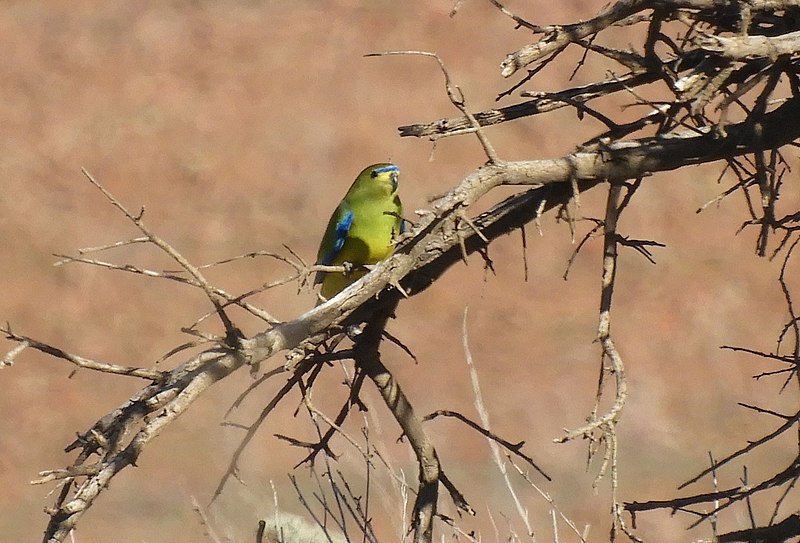
The Elegant Parrot is a beautiful species of parrot found only in Australia. It belongs to the Psittaculidae family and is commonly known as Neophema elegans.
The parrot was given its name by John Gould, a famous ornithologist and artist, in 1837. The species name comes from the Latin word “elegant,” which perfectly describes the bird’s graceful appearance.
Aboriginal peoples referred to it as carteri, bilgir, or koolyederong. The Elegant Parrot is one of six species of grass parrot in the Neophema genus.
Its striking colors, including a bright blue head and wings, make it a popular bird for aviculture.
However, the Elegant Parrot is still considered vulnerable in the wild due to habitat destruction and other threats.Scientific classification:
| Kingdom | Animalia |
| Phylum | Chordata |
| Class | Aves |
| Order | Psittaciformes |
| Family | Psittaculidae |
| Genus | Neophema |
| Species | N. elegans |
Also Featured In: Birds that Live in Kangaroo Island,
27. Western Gerygone
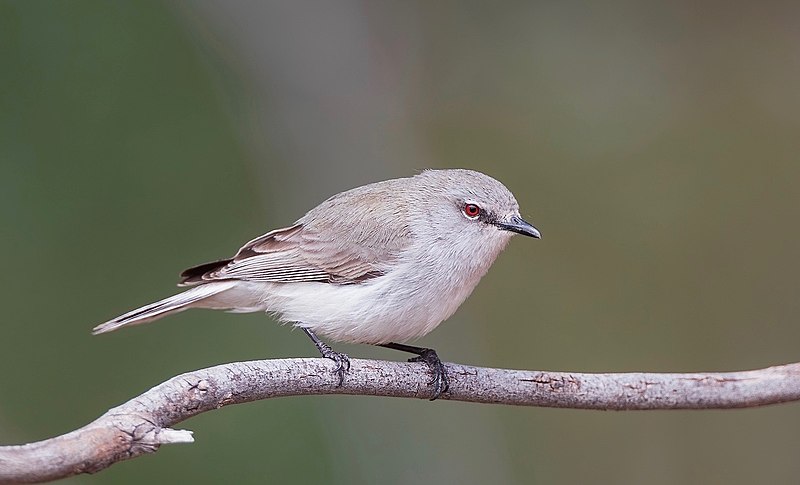
The Western gerygone is a tiny passerine bird found in inland and southwest Australia. It is known for its brownish-grey plumage and is an arboreal insectivore.
This species is commonly found in open forests, woodlands, and dry shrublands. They belong to the family Acanthizidae, which includes Thornbills and Allies.
Despite being such a small bird, they are not currently at risk of extinction (IUCN: Least Concern).
The Western gerygone is a fascinating bird, known for its unique song and calls. It feeds mainly on insects, which it catches while foraging in the canopy of trees.
Observing this species in their natural habitat can be a delightful experience for bird lovers and nature enthusiasts alike.Scientific classification:
| Kingdom | Animalia |
| Phylum | Chordata |
| Class | Aves |
| Order | Passeriformes |
| Family | Acanthizidae |
| Genus | Gerygone |
| Species | G. fusca |
28. Rufous Whistler
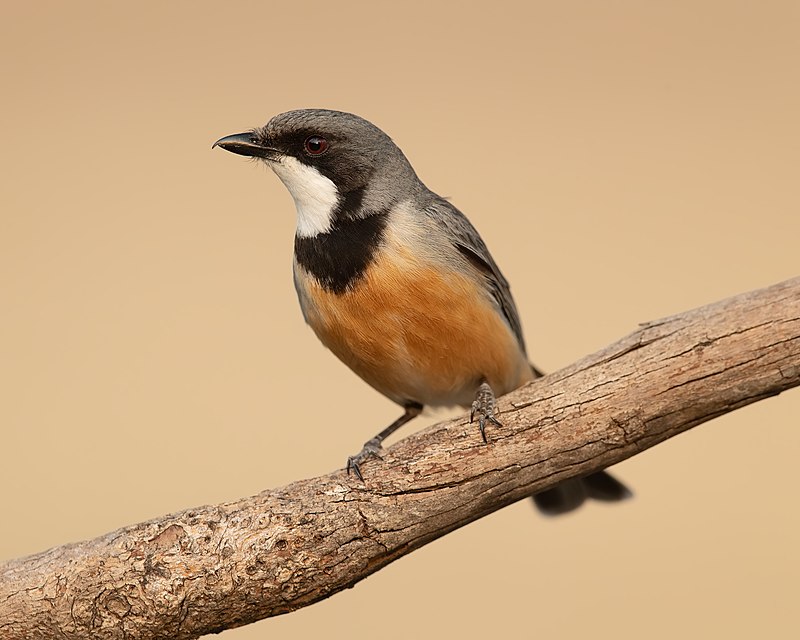
The Rufous whistler has reddish-brown and grey feathers that are not particularly flashy. However, it more than makes up for its subdued appearance with its impressive singing ability.
This bird species can be found in New Caledonia and Australia, where it is known for its variety of melodies and calls.
The Rufous whistler is a member of the Pachycephalidae family, which is known for its many musical calls.
It was initially classified in the Sylvia genus by the English ornithologist J.
Overall, the Rufous whistler is not the most visually striking bird, but its beautiful songs and calls make it a favorite among birdwatchers and nature enthusiasts.Scientific classification:
| Kingdom | Animalia |
| Phylum | Chordata |
| Class | Aves |
| Order | Passeriformes |
| Family | Pachycephalidae |
| Genus | Pachycephala |
| Species | P. rufiventris |
Also Featured In: Birds that Live in Sunshine Coast, Birds that Live in Gold Coasts
29. White-Cheeked Honeyeater
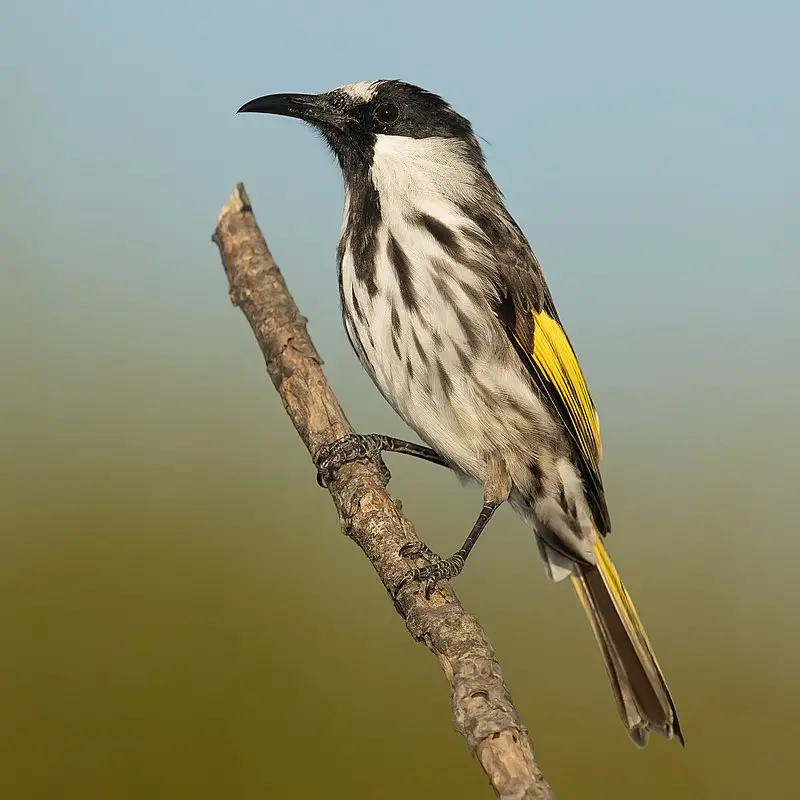
The White-cheeked honeyeater is a bird native to both the east coast and southwest corner of Australia. It is easily identifiable by its large white patch on the cheek, brown eyes, and yellow panel on its wing.
The bird was first described by Bechstein in 1811 and has two recognized subspecies: Phylidonyris niger niger in eastern Australia and P. n. gouldii in the southwestern corner of Western Australia.
These birds can often be seen flitting through the trees and shrubs in search of nectar, insects, and spiders to fuel their energetic lifestyles.
Their unique appearance and active behavior make them a favorite among bird watchers and nature enthusiasts alike.Scientific classification:
| Kingdom | Animalia |
| Phylum | Chordata |
| Class | Aves |
| Order | Passeriformes |
| Family | Meliphagidae |
| Genus | Phylidonyris |
| Species | P. niger |
30. Musk Duck
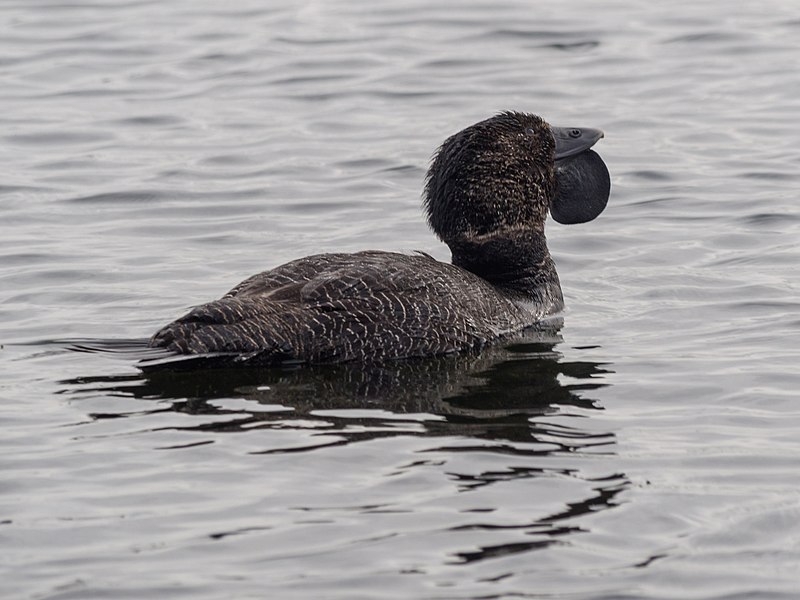
The musk duck is a unique water bird found in southern Australia. It is the only surviving member of the Biziura genus. An extinct relative was once present in New Zealand.
The New Zealand musk duck was larger than the surviving species, with a particularly large head. The musk duck is highly aquatic and has a distinctive stiff tail.Scientific classification:
| Kingdom | Animalia |
| Phylum | Chordata |
| Class | Aves |
| Order | Anseriformes |
| Family | Anatidae |
| Genus | Biziura |
| Species | B. lobata |
Also Featured In: Common Flinders Island Birds,
31. Australian Shelduck
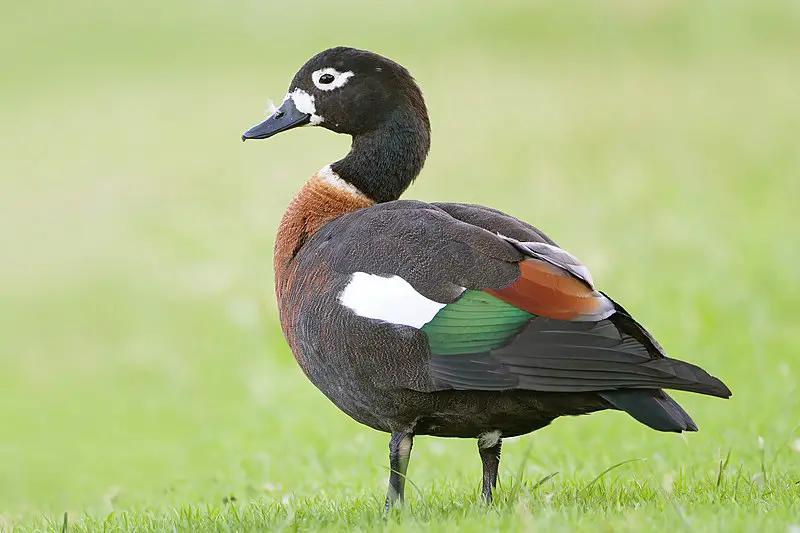
The Australian shelduck, known as the chestnut-breasted shelduck or mountain duck, is a large goose-like duck that is part of the Anatidae bird family. With their magnificent black body and chestnut-coloured breast, these birds are a striking sight.
The name Tadorna, which comes from Celtic roots, means “pied waterfowl.” Australian shelducks are protected under the National Parks and Wildlife Act 1974.
These unique birds are popular among birdwatchers and nature enthusiasts for their beauty and charisma.
They are often found near water sources and can be observed swimming, gliding, and diving in search of food.
In summary, the Australian shelduck is a beautiful, unique, and protected species of bird that adds to the diversity and charm of the Australian wildlife.Scientific classification:
| Kingdom | Animalia |
| Phylum | Chordata |
| Class | Aves |
| Order | Anseriformes |
| Family | Anatidae |
| Genus | Tadorna |
| Species | T. tadornoides |
32. Yellow-Billed Spoonbill
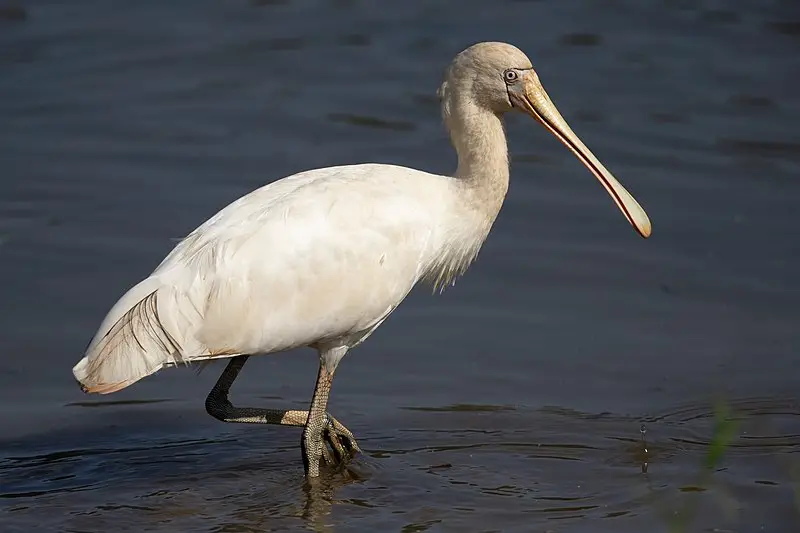
The yellow-billed spoonbill is a social bird belonging to the ibis and spoonbill family. It is found natively in Australia, with occasional sightings in New Zealand, Norfolk Island, and Lord Howe Island.
Its distinctness from other members of its genus was noted by ornithologist John Gould, who called it Platalea flavipes. With its distinctive yellow-tipped bill, it is easily recognizable.
The yellow-billed spoonbill primarily feeds on small aquatic creatures, using its bill like a spoon to scoop up food from the water.
It is also known for its striking white plumage, which contrasts with the black feathers on its wings. As a gregarious species, it is known for congregating in groups, especially during breeding season.
Despite its vulnerable status due to habitat loss and hunting pressures, conservation efforts are in place to protect this unique bird.Scientific classification:
| Kingdom | Animalia |
| Phylum | Chordata |
| Class | Aves |
| Order | Pelecaniformes |
| Family | Threskiornithidae |
| Genus | Platalea |
| Species | P. flavipes |
Also Featured In: Common Townsville Birds,
33. Blue-Billed Duck
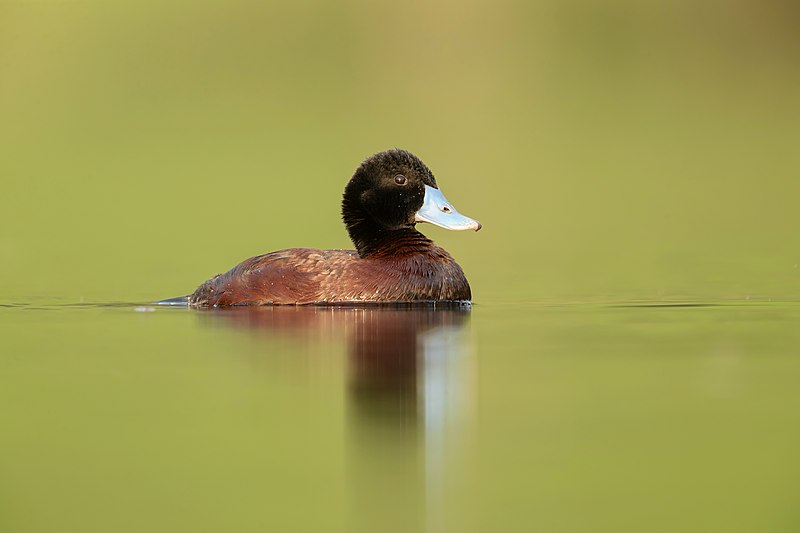
The Blue-billed duck is a small Australian waterbird that grows up to 40 cm long. It has a distinctive blue bill that turns brighter during breeding season, which is the reason behind its name.
Male Blue-billed ducks have chestnut plumage during breeding season which changes back to dark grey afterwards.
Females, on the other hand, retain their black plumage. The Blue-billed duck is a stiff-tailed duck that inhabits wetlands and shallow lakes.
It is commonly found in eastern and southeastern Australia, including Tasmania.
Despite being a relatively common species, it is considered to be vulnerable due to habitat loss, pollution, and hunting. Conservation efforts are underway to protect the Blue-billed duck and its habitat.Scientific classification:
| Kingdom | Animalia |
| Phylum | Chordata |
| Class | Aves |
| Order | Anseriformes |
| Family | Anatidae |
| Genus | Oxyura |
| Species | O. australis |
34. Western Wattlebird
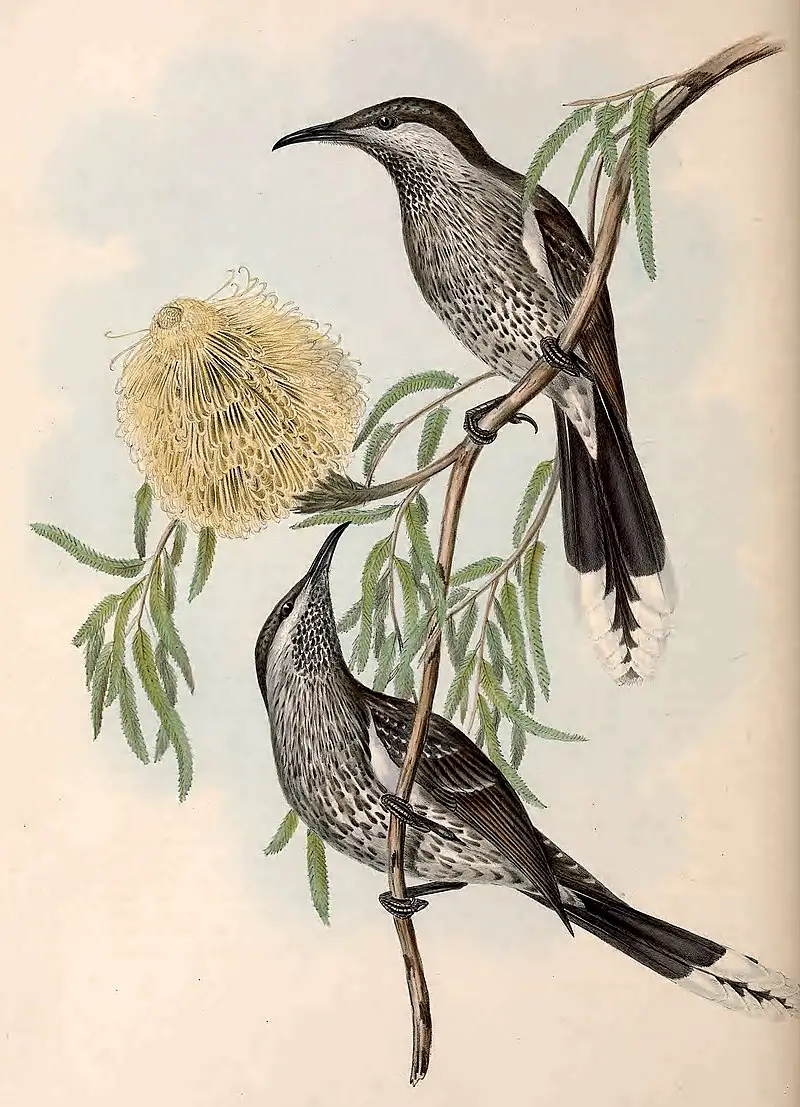
The Western wattlebird is a passerine bird found only in southwestern Australia. It belongs to the honeyeater family, Meliphagidae. Its description was first published by John Gould in 1838, from a specimen collected at Swan River.
The bird has a common name of “Lunulated Wattle-Bird,” as recorded in Gould’s The Birds of Australia, published in 1848.
This bird species feeds on nectar and insects, and can be found in a variety of habitats, including open heathland, dense forest, and urban gardens.
The Western wattlebird is known for its distinctive and melodious calls, which can often be heard throughout its range.
Its plumage is predominantly grey, with a colorful yellow patch on its belly and wattles on its face, which lend it a unique appearance. This bird is an important pollinator of many Western Australian plant species.Scientific classification:
| Kingdom | Animalia |
| Phylum | Chordata |
| Class | Aves |
| Order | Passeriformes |
| Family | Meliphagidae |
| Genus | Anthochaera |
| Species | A. lunulata |